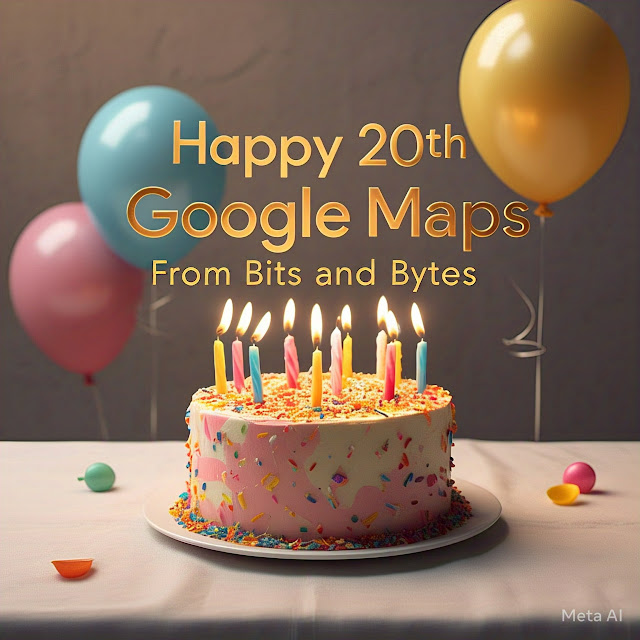@Mark Ollig
It was 20 years ago today when Google Maps was publicly released.
In 2003, Lars and Jens Rasmussen, Noel Gordon, and Stephen Ma, the founders of Where 2 Technologies, developed Expedition, a standalone desktop mapping software application in Sydney, Australia.
While the exact programming language for Expedition isn’t known (at least I haven’t found it), it likely used C++ for its mapping software and Geographic Information Systems (GIS), which involves managing and analyzing location-based data.
Expedition, with its user-friendly interface, laid the groundwork for the future development of Google Maps.
Google acquired Where 2 Technologies in October of 2004, after a reportedly fast-paced three-week negotiation with Google’s co-founder, Larry Page.
Google quickly transitioned Expedition into a web application, paving the way for the launch of Google Maps Feb. 8, 2005, featuring zoomable maps, driving directions, and a search function.
A Fresno Bee newspaper article, published Feb. 9, 2005, stated, “Google Maps puts the company squarely in competition with Yahoo Inc. and America Online Inc.’s MapQuest, part of Time Warner, Inc.”
MapQuest, one of the first web-based mapping services, was launched in 1996.
In 2005, Google Maps used JavaScript for dynamic user interface (UI) elements, allowing users to pan (move the map view in any direction), zoom in and out, and interact with information windows and the search bar.
Clicking on a pin or icon on the map (often shaped like a teardrop or a flag) activates the interactive feature that displays location details, such as the name and address of a business.
This interactive feature is primarily powered by JavaScript using AJAX (Asynchronous JavaScript) and XML (Extensible Markup Language) for data exchange.
AJAX enables asynchronous updates, allowing Google Maps to retrieve and display new data in nearly real-time without refreshing the page, and enhances background updates and dynamic responses to user interactions.
In 2005, Google Maps likely used XML to exchange data between browsers and servers, including map tiles, business location details, points of interest, search results, and direction data.
At the time, XML was a standard format for data exchange in AJAX-based web applications.
HTML (HyperText Markup Language) was used for web elements such as the search bar and pop-up windows.
CSS (Cascading Style Sheets) handled the visual elements, including colors, fonts, and overall design.
I compiled a list of the milestone years in the evolution of Google Maps:
2005: Google launched Google Maps, featuring satellite imagery, zoomable maps, driving directions, and a search function.
2007: ‘Street view’ offered 360-degree street-level imagery.
2008: Public transit directions became available, as did the mobile app providing turn-by-turn navigation.
2009: Google Maps added walking and cycling directions.
2011: Google Maps introduced indoor maps for malls, airports, and stadiums.
2012: Offline Google Map usage without an internet connection became available.
2014: Real-time traffic updates with alternate routes were added.
2015: Google began integrating AI-powered personalized recommendations for dining and other attractions, which today remains a process of continuous development and improvement.
2016: Google integrated ride-hailing services like Uber and also improved its offline navigation.
2017: Real-time location sharing allowed users to share their location with others.
2018: Google Maps became linked with Google Assistant and Google Photos.
2019: Google’s ‘live view’ introduced using augmented reality to overlay turn-by-turn directions on a smartphone’s camera.
2023: ‘Immersive view,’ combining street view and aerial imagery, was launched, allowing users to explore cities and landmarks in a more realistic 3D virtual environment.
2024: At the Google I/O (Innovation in the Open) developers conference, the company announced new location-aware AR features for live view.
Although not yet available to the public, location-aware AR will enable more precise placement of virtual objects and provide richer information about landmarks, businesses, and points of interest by overlaying historical images or 3D models.
As with nearly everything else these days, Google Maps uses artificial intelligence (AI) and machine learning (ML) to enhance accuracy and personalization.
AI analyzes satellite imagery and street view data to improve map updates by detecting roads, buildings, and landmarks.
ML forecasts traffic patterns, delays, and optimal routes using real-time and historical data, and provides personalized recommendations for restaurants and other businesses or activities based on user preferences and location history.
Google Maps also uses natural language processing (NLP) to understand human language.
Google Maps uses NLP to analyze reviews to gauge opinions and identify fake ones, interpret local search queries like “coffee near me,” and address user feedback on map issues and reviews.
Google Maps also employs neural radiance fields (NeRF), a relatively new AI technique that creates incredibly realistic 3D models from images.
NeRF technology enhances immersive view in Google Maps, allowing for more detailed and virtual explorations of places.
Google Maps depends on a robust telecom infrastructure, including 5G mobile networks, to support navigation, immersive view, and real-time features.
With low latency and high bandwidth, 5G is vital for delivering precise and reliable location data.
The internet backbone and CDNs (content delivery networks) ensure Google Maps’ global reach and efficient data distribution.
Location services in Google Maps depend on satellite GPS, GNSS (global navigation satellite systems), and terrestrial positioning methods like cellular and Wi-Fi triangulation to provide accurate location data.
Reflecting on the past, I, like many of you, remember the frustration of unfolding and refolding AAA paper maps that felt like working a jigsaw puzzle.
I’m glad we have Google Maps, and now it’s time to blow out those 20 candles!
